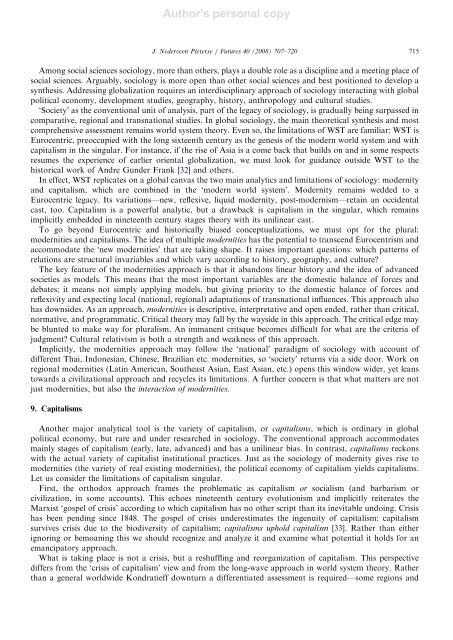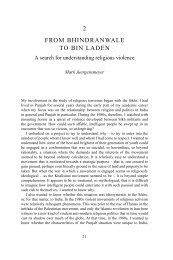New Glob Fu JFTR1275.pdf - Jan Nederveen Pieterse
New Glob Fu JFTR1275.pdf - Jan Nederveen Pieterse
New Glob Fu JFTR1275.pdf - Jan Nederveen Pieterse
Create successful ePaper yourself
Turn your PDF publications into a flip-book with our unique Google optimized e-Paper software.
Author's personal copy<br />
Among social sciences sociology, more than others, plays a double role as a discipline and a meeting place of<br />
social sciences. Arguably, sociology is more open than other social sciences and best positioned to develop a<br />
synthesis. Addressing globalization requires an interdisciplinary approach of sociology interacting with global<br />
political economy, development studies, geography, history, anthropology and cultural studies.<br />
‘Society’ as the conventional unit of analysis, part of the legacy of sociology, is gradually being surpassed in<br />
comparative, regional and transnational studies. In global sociology, the main theoretical synthesis and most<br />
comprehensive assessment remains world system theory. Even so, the limitations of WST are familiar: WST is<br />
Eurocentric, preoccupied with the long sixteenth century as the genesis of the modern world system and with<br />
capitalism in the singular. For instance, if the rise of Asia is a come back that builds on and in some respects<br />
resumes the experience of earlier oriental globalization, we must look for guidance outside WST to the<br />
historical work of Andre Gunder Frank [32] and others.<br />
In effect, WST replicates on a global canvas the two main analytics and limitations of sociology: modernity<br />
and capitalism, which are combined in the ‘modern world system’. Modernity remains wedded to a<br />
Eurocentric legacy. Its variations—new, reflexive, liquid modernity, post-modernism—retain an occidental<br />
cast, too. Capitalism is a powerful analytic, but a drawback is capitalism in the singular, which remains<br />
implicitly embedded in nineteenth century stages theory with its unilinear cast.<br />
To go beyond Eurocentric and historically biased conceptualizations, we must opt for the plural:<br />
modernities and capitalisms. The idea of multiple modernities has the potential to transcend Eurocentrism and<br />
accommodate the ‘new modernities’ that are taking shape. It raises important questions: which patterns of<br />
relations are structural invariables and which vary according to history, geography, and culture?<br />
The key feature of the modernities approach is that it abandons linear history and the idea of advanced<br />
societies as models. This means that the most important variables are the domestic balance of forces and<br />
debates; it means not simply applying models, but giving priority to the domestic balance of forces and<br />
reflexivity and expecting local (national, regional) adaptations of transnational influences. This approach also<br />
has downsides. As an approach, modernities is descriptive, interpretative and open ended, rather than critical,<br />
normative, and programmatic. Critical theory may fall by the wayside in this approach. The critical edge may<br />
be blunted to make way for pluralism. An immanent critique becomes difficult for what are the criteria of<br />
judgment? Cultural relativism is both a strength and weakness of this approach.<br />
Implicitly, the modernities approach may follow the ‘national’ paradigm of sociology with account of<br />
different Thai, Indonesian, Chinese, Brazilian etc. modernities, so ‘society’ returns via a side door. Work on<br />
regional modernities (Latin American, Southeast Asian, East Asian, etc.) opens this window wider, yet leans<br />
towards a civilizational approach and recycles its limitations. A further concern is that what matters are not<br />
just modernities, but also the interaction of modernities.<br />
9. Capitalisms<br />
ARTICLE IN PRESS<br />
J. <strong>Nederveen</strong> <strong>Pieterse</strong> / <strong>Fu</strong>tures 40 (2008) 707–720 715<br />
Another major analytical tool is the variety of capitalism, or capitalisms, which is ordinary in global<br />
political economy, but rare and under researched in sociology. The conventional approach accommodates<br />
mainly stages of capitalism (early, late, advanced) and has a unilinear bias. In contrast, capitalisms reckons<br />
with the actual variety of capitalist institutional practices. Just as the sociology of modernity gives rise to<br />
modernities (the variety of real existing modernities), the political economy of capitalism yields capitalisms.<br />
Let us consider the limitations of capitalism singular.<br />
First, the orthodox approach frames the problematic as capitalism or socialism (and barbarism or<br />
civilization, in some accounts). This echoes nineteenth century evolutionism and implicitly reiterates the<br />
Marxist ‘gospel of crisis’ according to which capitalism has no other script than its inevitable undoing. Crisis<br />
has been pending since 1848. The gospel of crisis underestimates the ingenuity of capitalism: capitalism<br />
survives crisis due to the biodiversity of capitalism; capitalisms uphold capitalism [33]. Rather than either<br />
ignoring or bemoaning this we should recognize and analyze it and examine what potential it holds for an<br />
emancipatory approach.<br />
What is taking place is not a crisis, but a reshuffling and reorganization of capitalism. This perspective<br />
differs from the ‘crisis of capitalism’ view and from the long-wave approach in world system theory. Rather<br />
than a general worldwide Kondratieff downturn a differentiated assessment is required—some regions and





